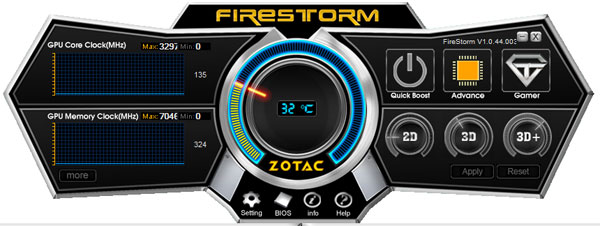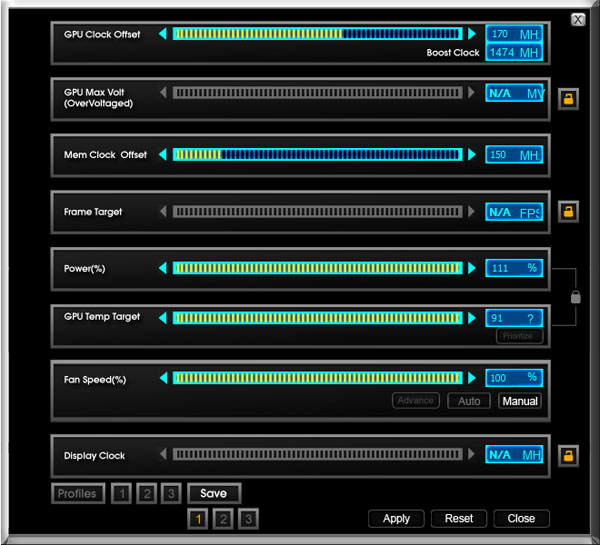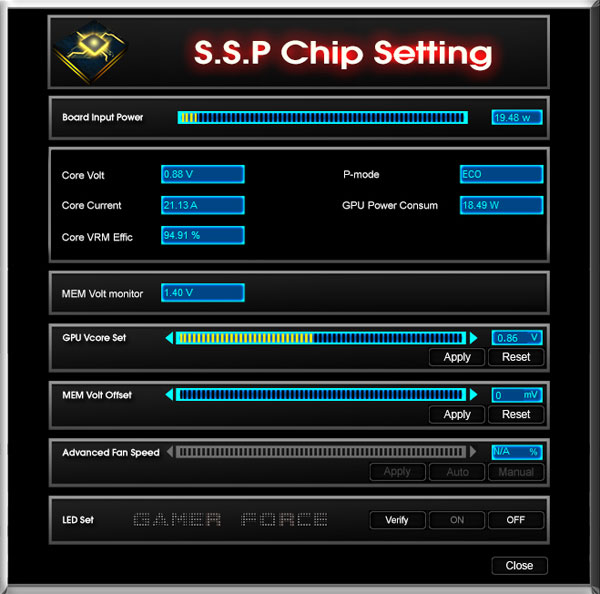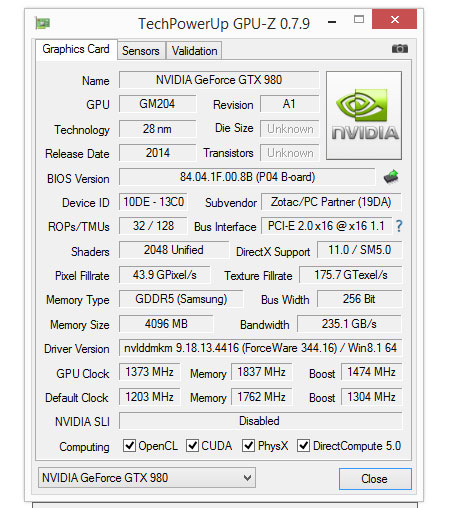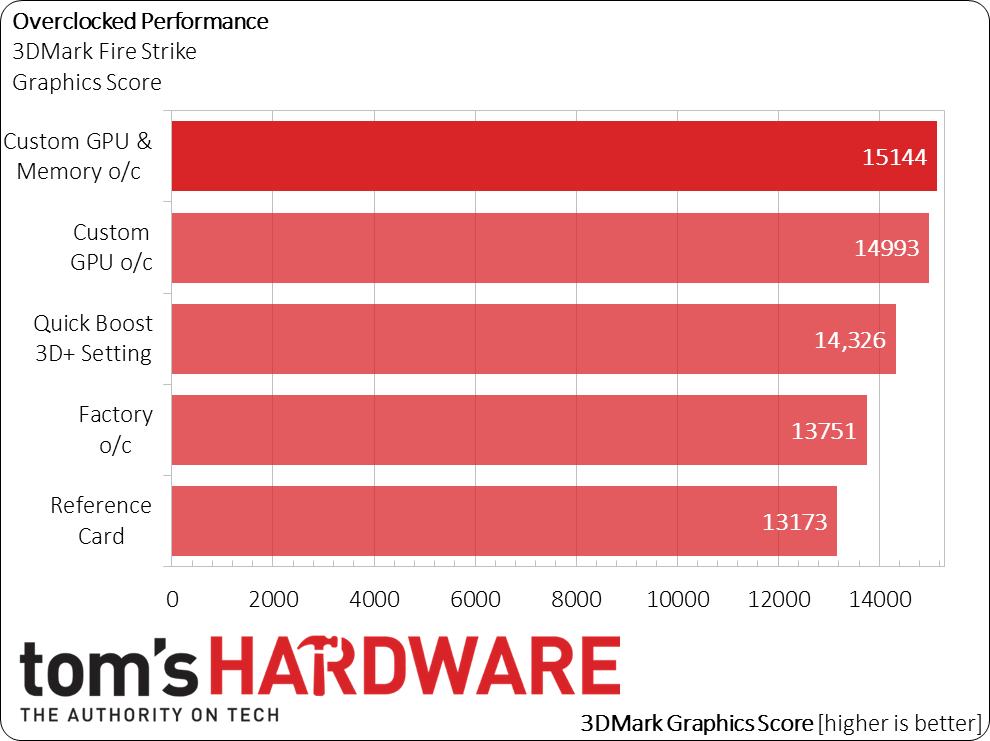Zotac GeForce GTX 980 AMP! Omega Edition Review: The Big Gun
Zotac's GeForce GTX 980 AMP! Omega edition boasts a large aftermarket cooling solution enabling an aggressive factory overclock. How does the board perform right out of its box? How about after we try to push it even harder?
Why you can trust Tom's Hardware
Overclocking Performance
When it comes to overclocking, as always, we start by reminding you that the luck of the draw is a key consideration. Despite the variables beyond our control, we're still interested in seeing how far we can push Zotac's AMP! Omega card.
Unfortunately, our experience with the new Firestorm utility didn't go as smoothly as we would have liked. At first, we had no success getting it to work. We were told to upgrade to version 10.44.003 and still had no luck. Finally, a Zotac representative told us that we needed to launch the application as an administrator. Success! We were also told that the company is aware of the problem and working on a solution.
Moving on. This is Zotac's new FireStorm interface. You might recall that the previous version appeared similar to MSI's Afterburner utility, so the company went for a more stylistic look this time.
While the temperature and clock rate indicators do their jobs, the user interface is an exercise in miscommunication. We're expected to somehow deduce that the 2D, 3D, and 3D+ fields below the Quick Boost button indicate three different levels of acceleration. Why not give them more explanatory labels, such as Quick Boost level one, two and three? And the Advance button should be labeled "Manual Settings", while the "Gamer" button should be called "OC+ Settings". Clear, simple labeling is both easy to implement and crucial to a piece of software's success. There is no excuse for buttons that have confusing labels. Sorry folks; I'll get off my interface critique soap box now. Lets get back to the review.
Click the "Advance" button and you are presented the following window, with basic overclocking settings:
Unlike the front-end's buttons, these settings are easy enough to understand. The only strange inclusion is GPU overvoltage, which is disabled. It can only be adjusted from the OC+ window, accessed via the "Gamer" button.
Note the settings we used for our maximum overclock. The card's BIOS limits its power target to a maximum of 111%. That's a surprising limitation for what appears to be over-engineered hardware, especially considering that the reference GeForce GTX 980 has a 125% power target limit. This limitation severely curtails the card's overclocking ceiling. Granted, the AMP! Omega's TDP is slightly higher than the reference card by about 5W, according to our testing, hitting about 170W. An 11-percent bump takes it to the 190W range. Compare that to the reference card's 165W TDP, which stretches to 205W at 125%. In other words, a reference GeForce GTX 980 has more overclocking flexibility than Zotac's AMP! Omega. The hardware may be willing, but the BIOS limitations are weak.
Get Tom's Hardware's best news and in-depth reviews, straight to your inbox.
In order to adjust GPU voltage, we need to access the OC+ settings by clicking "Gamer", which provides another pop-up window titled with the unexplained acronym "S.S.P". So, Gamer is equal to OC+ is equal to S.S.P.? Ugh.
This window is only accessible if your graphics card has OC+ functionality and the USB cable is attached. There's some unique information, but the important stuff for overclockers is the GPU Vcore and memory voltage controls. The Vcore allows adjustment from 0.5 to 1.26V, while the memory voltage allows only a single-step 20mV bump. Unfortunately, we experienced occasional lock-ups when we modified the GPU voltage.
Not that the imposed ceiling mattered. We actually had to lower GPU voltage from the stock 0.88V to 0.86V because the power limit hamstrung us more than the GPU's voltage scale.
Our maximum stable overclock topped out at a 1373MHz base clock rate with a typical 1474MHz GPU Boost frequency, plus 1837MHz (7348MT/s) GDDR5 memory. While we could dial in more aggressive settings, the power limit eventually shut us down under load. To be fair, that's a respectable overclock. But we really think that this hardware has a lot more to give. If it only matched the reference card's 125% power limit, I think that Zotac's AMP! Omega edition would have shown us a much better result.
At the end of the day, we achieved a solid 15% performance increase in 3DMark Fire Strike compared to the reference GeForce GTX 980, and that's nothing to be ashamed of. Even the Firestorm utility's one-click overclocking capability impresses; the Quick Boost 3D+ setting yielded a 1273MHz base and 1374MHz GPU Boost setting with 1779MHz memory, granting a 9% performance improvement over reference.
Current page: Overclocking Performance
Prev Page Temperature, Noise And Power Benchmarks Next Page A Big Gun Limited By A Small MagazineDon Woligroski was a former senior hardware editor for Tom's Hardware. He has covered a wide range of PC hardware topics, including CPUs, GPUs, system building, and emerging technologies.
-
chimera201 "which allows us to provide a stable higher factory clock setting without reducing the lifespan of the components of the graphics card"Reply
Almost everyone needs a GPU upgrade in less than 3 years. Who cares about the lifespan if it is more than 3 years?
-
MeteorsRaining It's ridiculous to see this card doesn't provide the actual OCing experience one hopes for. Out of the box OC is good, but one simply doesn't expect it to be enough, atleast not for the card in the OCing segment of the brand. This was supposed to be a OCer's card, it failed on those terms. Too many software-bound restrictions. But yes, the hardware does look quite appealing.Reply -
ralanahm did you try the nitro boost switch to see if that unlocks the locks. I would hope for a fw or software update.Reply -
mapesdhs Not impressed with the Zotac at all.Reply
I bought an EVGA 980 ACX 2.0 (1266 base clock, 1367 boost), it scores 14260 for
the Firestrike test just at default settings, it's a proper 2 slot card, much quieter
(the fans don't turn on until the GPU goes over 65C) and from what I've read will
oc better. Also, in the UK the EVGA card is 35 to 40 UKP cheaper; I can't imagine
why anyone would buy the Zotac.
Don, did you try using Afterburner instead for the oc tests?
Ian.
-
jasonelmore So zotac goes and over engineer's the hell out of a 980, adding LN2 dip switches, Voltage Readouts, Beefed up power delivery, High performance inductors, and then what do they do?Reply
They lower the TDP by 11%, when compared to the Nvidia Reference Model. Whats the use of LN2 features if your going to handicap the voltage cap?
My reference 980 hit 1.5ghz with ease. 1st try overclock actually. And reference board is using the cheapest coils and inductors money can buy. -
WithoutWeakness What is the point of this monstrosity of a card? It has an oversized PCB and massive 2.5-slot open air cooler and isn't any faster, cooler, or quieter than Nvidia's reference design. GM104 is only a 165W chip and Zotac designs this huge overkill cooler and it's no better than Nvidia's rear-exhaust design AND takes up 3 slots? What a joke.Reply -
The original Derfman Seriously people, you sound like the kind of people that would buy a $100,000 muscle car, then bitch that you can't turn it into a formula dragster and still drive it on the street. This card is seriously overclocked already and yet people still want more, with an intact warranty. Spoiled much?Reply -
coolitic Apparently I can't rate posts if I don't disable adblock.Reply
Toms is really pissing everyone off.
